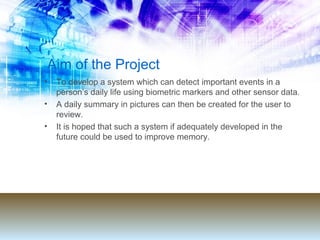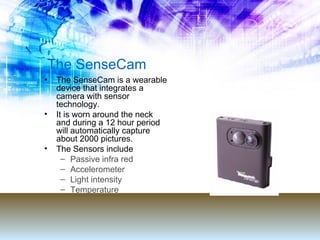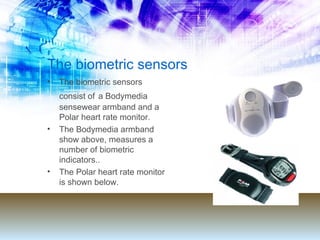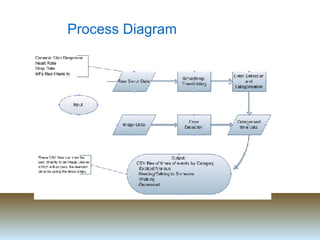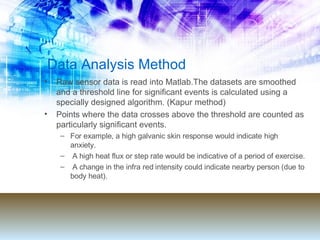Analysis of Biometric Data for Memory Augmentation using a SenseCam (midterm)
- 1. Analysis of Biometric Data for Memory Augmentation using a SenseCam Eoin Lynch
- 2. Aim of the Project To develop a system which can detect important events in a person’s daily life using biometric markers and other sensor data. A daily summary in pictures can then be created for the user to review. It is hoped that such a system if adequately developed in the future could be used to improve memory.
- 3. The SenseCam The SenseCam is a wearable device that integrates a camera with sensor technology. It is worn around the neck and during a 12 hour period will automatically capture about 2000 pictures. The Sensors include Passive infra red Accelerometer Light intensity Temperature
- 4. The biometric sensors The biometric sensors consist of a Bodymedia sensewear armband and a Polar heart rate monitor. The Bodymedia armband show above, measures a number of biometric indicators.. The Polar heart rate monitor is shown below.
- 6. Data Analysis Method Raw sensor data is read into Matlab.The datasets are smoothed and a threshold line for significant events is calculated using a specially designed algorithm. (Kapur method) Points where the data crosses above the threshold are counted as particularly significant events. For example, a high galvanic skin response would indicate high anxiety. A high heat flux or step rate would be indicative of a period of exercise. A change in the infra red intensity could indicate nearby person (due to body heat).
- 7. Sample data set showing threshold line
- 8. Image Processing The SenseCam images can be analysed to determine which contain people. Skin tones are segmented from the rest of the image. Pixcels with skin are set to white. Those not are set to black. If more than a certain coverage of white is detected after segmentation the presence of a person is assumed.
- 9. Results Detection of emotionally intensive events is relatively straight forward, Determining which emotion is present is not. Further sensor data from different sources such as muscle electromyography or facial expression detection are likely to be necessary to accomplish this. This is due to the fact that many experiences can produce similar responses in basic biometric markers. In most instances it was clear from the image, to the user, why the program may have regarded it as a significant event. eg.Talking to someone important, eating, running, watching an interesting film.
- 10. What next? Segmenting the day into events and analysing these independently Trying to establish classifiers for emotional states. Subjecting the data to a more rigorous set of experiments to determine something more concrete.

